Bass is a generic common name shared by many species of ray-finned fish from the large clade Percomorpha, mainly belonging to the orders Perciformes and Moroniformes, encompassing both freshwater and marine species. The word bass comes from Middle English bars, meaning "perch", despite that none of the commonly referred bass species belong to the perch family Percidae.
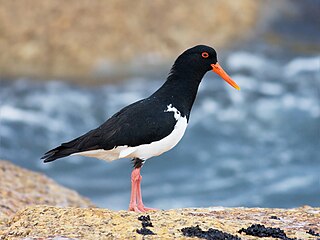
The oystercatchers are a group of waders forming the family Haematopodidae, which has a single genus, Haematopus. They are found on coasts worldwide apart from the polar regions and some tropical regions of Africa and South East Asia. The exceptions to this are the Eurasian oystercatcher, the South Island oystercatcher, and the Magellanic oystercatcher, which also breed inland, far inland in some cases. In the past there has been a great deal of confusion as to the species limits, with discrete populations of all black oystercatchers being afforded specific status but pied oystercatchers being considered one single species.

Pilosella aurantiaca is a perennial flowering plant in the family Asteraceae that is native to alpine regions of central and southern Europe, where it is protected in several regions.
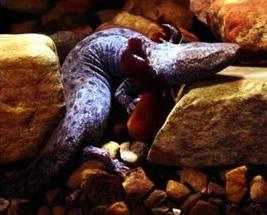
The family Proteidae is a group of aquatic salamanders found today in the Balkan Peninsula and North America. The range of the genus Necturus runs from southern central Canada, through the midwestern United States, east to North Carolina and south to Georgia and Mississippi. The range of the olm, the only extant member of the genus Proteus, is limited to the Western Balkans. The fossil record of the family extends into the end of the Late Cretaceous, with Paranecturus being known from the Maastrichtian of North America.

The worm-eating warbler is a small New World warbler that breeds in the Eastern United States and migrates to southern Mexico, the Caribbean, and Central America for the winter.

Ascaris is a nematode genus of parasitic worms known as the "small intestinal roundworms", which is a type of parasitic worm. One species, Ascaris lumbricoides, affects humans and causes the disease ascariasis. Another species, Ascaris suum, typically infects pigs. Other ascarid genera infect other animals, such as Parascaris equorum, the equine roundworm, and Toxocara and Toxascaris, which infect dogs and cats.

The golden mantella is a small, terrestrial frog endemic to Madagascar. It has an extremely restricted distribution in three distinct areas centered on the town of Moramanga - Beparasy and Ambohibary Communes, Torotorofotsy Wetland northwest of Andasibe, and in the area of Ambakoana. Mantella aurantiaca is one of Madagascar's most threatened amphibian species due to its limited distribution in an area under tremendous anthropogenic pressure. It may also be threatened by over-collection for the pet trade.

Peltobatrachus is an extinct genus of temnospondyl amphibian from the late Permian period of Tanzania. The sole species, Peltobatrachus pustulatus, is also the sole member of the family Peltobatrachidae.

Hygrophoropsis aurantiaca, commonly known as the false chanterelle, is a species of fungus in the family Hygrophoropsidaceae. It is found across several continents, growing in woodland and heathland, and sometimes on woodchips used in gardening and landscaping. Fruit bodies (mushrooms) are yellow–orange, with a funnel-shaped cap up to 8 cm across that has a felt-like surface. The thin, often forked gills on the underside of the cap run partway down the length of the otherwise smooth stipe. Reports on the mushroom's edibility vary – it is considered poisonous, but has historically been eaten in parts of Europe and the Americas.
The Gemmatimonadota are a phylum of bacteria established in 2003. The phylum contains two classes Gemmatimonadetes and Longimicrobia.
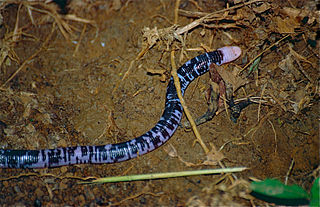
Amphisbaena fuliginosa, also known as the black-and-white worm lizard, speckled worm lizard or spotted worm lizard, is a species of amphisbaenian in the genus Amphisbaena. The ecology of A. fuliginosa is poorly known due to its fossorial habits. However, this species can be easily distinguished from others because of its characteristic white and black mosaic pattern that covers both the dorsal and ventral side.

Anemone hortensis, commonly called broad-leaved anemone, is a perennial herbaceous flowering plant with an underground rhizome, in buttercup family Ranunculaceae. The genus name comes from the Greek ἄνεμος, as an ancient legend tells that the flowers open only when the wind blows. The species name hortensis refers to the easiness with which this plant can be cultivated.

Pectocaris is an extinct genus of bivalved arthropods from the Cambrian Maotianshan Shales, Yunnan Province of China. There are currently three known species within the genus.

Hygrophoropsis is a genus of gilled fungi in the family Hygrophoropsidaceae. It was circumscribed in 1888 to contain the type species, H. aurantiaca, a widespread fungus that, based on its appearance, has been affiliated with Cantharellus, Clitocybe, and Paxillus. Modern molecular phylogenetic analysis shows that the genus belongs to the suborder Coniophorineae of the order Boletales.

Ferocactus hamatacanthus, commonly named Turk's Head, is a barrel cactus in the tribe Cacteae.
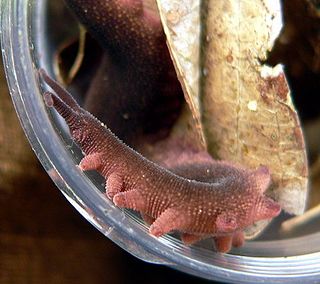
Eoperipatus totoro is a species of velvet worm of the family Peripatidae discovered in Vietnam in 2007. As of 2013, it is the only velvet worm known from Vietnam. The specific name is derived from caterpillar-like Catbus from the Japanese animated film My Neighbor Totoro. It has a distinct feature from other worms in having uniquely shaped hairs on its body surface. Its ability to spit out nets of sticky glue from its appendages is used for catching prey. Like other velvet worms in this genus, this species exhibits lecithotrophic ovoviviparity; that is, mothers in this genus retain yolky eggs in their uteri.
The Oriental worm-eel, also known as the Oriental snake eel, the Oriental sand-eel or the finny sand-eel, is an eel in the family Ophichthidae. It was described by John McClelland in 1844, originally under the genus Dalophis. It is a tropical, marine and freshwater-dwelling eel which is known from the Indo-Western Pacific, including Somalia, South Africa, India, Papua New Guinea, Tahiti, French Polynesia, Indonesia, Oman, Palau, New Caledonia, the Philippines, Sri Lanka, Seychelles, and Vanuatu. It dwells at a depth range of 0 to 3 metres, and forms burrows in sand and mud sediments in estuaries, rivers, and inshore turbid waters. Males can reach a maximum total length of 36 centimetres (14 in), but more commonly reach a TL of 25 centimetres (9.8 in).

Condylactis aurantiaca, commonly known as the golden anemone, is a species of sea anemone in the family Actiniidae. This species always remains largely buried in sand or sediment, attached to the substrate, with only the oral disc and tentacles visible.
Phallocephale is a monospecific genus of ovoviviparous velvet worm containing the single species Phallocephale tallagandensis. Males are distinguished by the presence of an eversible knoblike structure on the head, whereas females instead have a depression on their head. This species has 15 pairs of legs in both sexes. The type locality of this species is Tallaganda National Park, New South Wales, Australia. This species exhibits lecithotrophic ovoviviparity; that is, mothers in this species retain yolky eggs in their uteri.
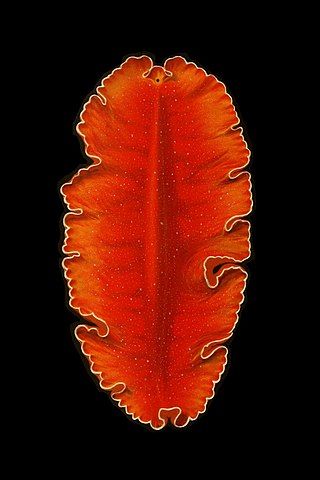
Yungia aurantiaca is a species of flatworm in the family Pseudocerotidae. It is found in the temperate northeastern Atlantic Ocean and the Mediterranean Sea.















